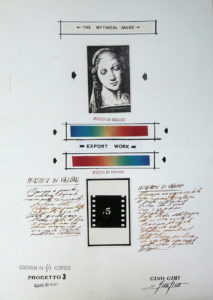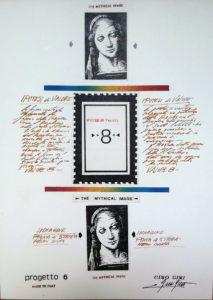Critical thought by A. Anelli on 'the mythical image' by Gino Gini
A turning point: Gino Gini “The Mythical Image” (1976 – 1981)
by Amedeo Anelli
The relationships between thought, concept and visual arts in the twentieth century are intricate and with paradoxical and highly aporetic outcomes.
This depends, in part, on the traditions in the field, both in Art and in the aesthetic-philosophical approach to which one consciously or passively adheres or to which one adhered.
Furthermore, counter-practical processes of widespread epigonality and standardization are added with the consequent emptying of values and forms of exaggerated subjectivism and idiolects (most often of only psychological and sociological interest).
Emptying of values, tangible facts in the second half of the twentieth century in a process of commodification and marginalization of aesthetic-artistic exchanges, with the consequent expulsion from a self-referential and other-directed market of almost everything that cannot be immediately monetized or expressed in terms of power and income .
Thus the poetics that revolved around the “Concept” and Conceptual Art in the 1970s “diffracted” into variegated and extreme figures.
From Nominalism and from the subjection and eavesdropping of Structural Linguistics or from Pragmatics – as in various forms in the Art-language – or from some science of man, as the extreme effect of reality from pure theory, detached from the sensible and the perceptible and, sometimes , hallucinatory *1.
On the other hand, in artists of solid preparation, both technical and cultural, the conceptual climate shapes forms, focuses, reflexivity that will serve for a wider planning for the works to come.
In any case, this work of desensitization, of placing the object in parentheses, of mentalism, finds acceptance above all in Italy in those components, in which the road was already paved by idealist aesthetics. Above all, from crocianesimo, for which the artistic technique was a problem (and as such expelled from the artistry) and the material realization of the work was a mere aid to memory, since the work was already completed in the author’s mind, in the interweaving of intuition and expression.
How then, however, the conceptual “stimmung”, in the years of maximum splendour, the decade we are dealing with – the Seventies – never definitively moved away from the production of some kind of “object” and, ultimately, has opened the doors to more than one dissignification, to technical carelessness and to a lot of trash and kitsch, it is an affair that concerns the following years.
In a period of strong commitment, even civil, such as the 1970s, the conceptual movement nonetheless represented a moment of reflection around the value of art, its relationship with criticism (which it thought it could do without), and a challenge to aesthetics.
Furthermore, in this process produced by effects of reality, borrowed from theories and poetics still with a Neoplatonic and idealistic imprint, in the brutal reduction to the mental and in the consequent process of destructuring, leads to dissignification and poetic residuality all within the nineteenth-century traditions: in the polarization between the poetics of the subject and those of the object, such as to undermine the very idea of artistry in a widespread aesthetic desublimation.
But for those who, then, in the seventies came from a solid technical preparation and intellectual rigor, the possibilities triggered by conceptual art opened an internal dialectic between civil commitment, artistry and thinking about Art, which in fact led to an operational tension in multiple, unexpected and original directions.
This is the case of Gino Gini who, with The Mythical Image, detaches himself from a solid representative painting in the “traditional” sense – even if shrewd in crossing contemporary poetics and expressed in the cycles of oil paintings of Paesaggi and La Città and in the more enigmatic and thoughtful one of the acrylics of Habitat in which the metropolitan and also alienative dimension is present in the isolation of the human figure and the object -, to arrive at the works in question, from the period 1976 -1981.
These represent a real personal investigation into the value and conditions of the image, as well as the work of art; a journey into the interiority of the great Italian tradition and of art itself with iconic references to Caravaggio’s Canestra and to the Madonnas of Raphael or Giovanni Bellini, which become pure icons, pure images, in an unveiling and in an open project.
This of the undocking of the image from the original, to cross different media and multiple artistic and situational corporeities, is the first step of a planning open on many registers.
In the age of reproducibility and affluent society, the work and the images derived from them do not lose, according to a vision indebted to nineteenth-century aesthetics, an “aura” that they never had, but enter into a conflict of meanings and dissignifications in a fluid and multilayered situational relationship.
Thus Gino Gini’s works of this period question these possibilities and these stratifications, not only along the paths of irony and desublimation, but in the construction of their own paths and in an open and civil idea of production and enhancement of the work of art.
All this, as we will see – in many artists of the period to make the piece unique or not –, exploiting serial and also easily reproducible techniques of the copy shop, graphics and industrial design repertoire, turning the immeasurable to the immeasurable, the continuum to the discreet, in a close relationship with the imaginary city and the industrial product.
An outcome that will lead Gino Gini in the following years to works of the possible, in which the project is designed in a series of multiple references, and in an intense confrontation with painting-painting.
In this questioning of the image value of great icons of the figurative culture of our civilization, Gini equips himself with tools, indicators, figures, stylistic ways that will become typical of subsequent paths, from mail-art to art books and d artist, to every iconic journey to come.
If we take the 1976 works of The Mythical Image at its first appearance, here is the image of Caravaggio’s Canestra, a Madonna and the Marriage of the Virgin by Raphael, or the Madonna and Child (Madonna di Alzano) by Giovanni Bellini with the characteristic pear. The icon is decomposed, cut out, reduced to its “photographic” and plastic values of black and white, decomposed into its elements in geometric formants, transported into possible worlds by possible chromatic spectrums, concealed in pure form or in particulars, subjected to anomalous and ironic as the center of a dart board with corresponding numerical value. The works are arranged ad libitum in sign-sequences.
Everything is under the rule of indicating arrows, deictics (titles, scriptures further specify and direct towards further paths), in the rigorous three-way scansion of the image and in a mensural architecture in multiples of three.
Black and white is also played out in the full-empty relationship of the “frames”, in an allusion to a numerical-geometric sacredness and its envelopes which are also desublimating.
Obviously the original iconographic and iconological values (for example the pear in Bellini’s painting) are placed in brackets or hidden in a suggestion of possible transformations and transpositions.
Whether it is not a question of simple decontextualization of the form or of formal geometric relationships, but of a work of interrogation concerning a possible journey into the body of art, it can be seen in the stubborn multiplication and sequencing of the parameters of form, colour, number, value, suggestion, in continuous references to what is removed, highlighted, placed, formed.
The imaginary and the proper body of the works, in a polytechnic rendering and in the painting-writing interventions, is what we said of the imaginary, photographic-industrial-typographic, metropolitan and industrial of the seventies, starting from the use of paper metal, reflective and decontextualizing.
In the following years up to 1981, this system is subjected to a combinatorial order that benefits from the chosen icon and permutations of shape, colour, architectural cage, suggestions of numerological value, formal casts, presence or absence of compositional elements of the original image.
In 1979 the image of photographic film made its appearance and in 1981 the typical perforation of stamps, in which a full image or its opposite is enclosed.
This play of full and empty iconic values and their transformation in an aniconic sense and new planning, even ironic, focuses on a subsequent path of new planning detached from the fetishism of the image and its reproducibility for mercantile and functional purposes.
In these years the accent was also political, social and civil, in the first occurrence in Italy of phenomena of reaction to indiscriminate consumption, to the fetishization and extended dissignification for purposes of pure commercial gain.
In 1981, at the end of this cycle, the modes of production were also represented in an “otensive” way, in turn reduced to icons: sharp pencils and photographic gratings, spectra, color backgrounds and attention and register indicators, in a closing in on itself of the operation.
All this is not without correlation with the use, in various disciplines not only artistic, of patterns and formants or models in continuous transformation.
A prime example is the formation of a Semiography of the new Music in the previous century, which unified the notation systems and which accounted for athematic compositions, rhythmic fragmentation, aleatory figures, sound bands, gestures, noises and so on3. In Gini the afferent system is more suited to the tools of a formal critique, however subtracted from this function and placed in a system of imaginative and mensural transformations, relaunched along the line of a new planning and indeterminism.
The works of The Mythical Image become increasingly articulated and complex as we move towards 1981, with the introduction, even declarative, of Hypothesis of Colour, Hypothesis of use, Hypothesis of value, Made in Italy,, Slot Machine, Export Work by Your’s Instruments we were talking about, the complete disappearance of the original icon to focus only on the transformation methods.
In addition to the word Post card and that of Hypothesis, the word Progetto begins to appear with the consequent serial numbers.
Which journeys this new compositional team will take us to is a matter for the years to come.
*1) Cfr. Amedeo Anelli, Novanta. Verso un’Arte di Pensiero, Pistoia, C.R.T., 1999.
*2) Ermanno Migliorini, Conceptual Art, Firenze, Fiorino, 1979, p. 3.
*3) Cfr. Luigi Donorà, Semiografia della Nuova Musica, Padova, Zanibon, 1978.


